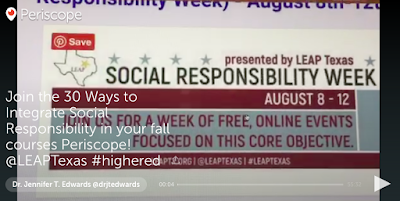While planning for the upcoming semester, I incorporate a large assignment on my syllabus. This large assignment was an important assignment for the undergraduate students as well as the graduate students in my courses in the Communication Studies Department at Tarleton State University.
When Periscope became a new technology utilized by many companies last summer, I decided to incorporate the technology in my course to expose the graduate students to a potential technology that can be implemented for a company or organization.
Step 1 - Creating the Assignment
Then, I created the following assignment description on my syllabus:
Group Research Paper - Topic: Internal Communication and Businesses/Corporations/Organizations and Public Social Media Spaces
Brief Description – This semester’s research study will focus on internal communication occurring in public social media spaces among organizations (companies, associations, corporations, non-profit orgs., etc.) and their employees/members.
A - Each component of this paper will be due on specific dates (as indicated on the syllabus calendar).
B - Each group member (groups of 3-4 individuals) is required to significantly contribute to the production of the paper. Each group member is responsible for contributing significant comments on the Google Document each week to sections for which their name is not assigned. Group members who do not contribute each week will receive a grade reduction for that particular week.
C - Please remember to submit questions by 4pm on Friday. Questions submitted after 4pm will not be answered until Monday morning.
Each component of this paper will be due on specific dates (as indicated on the syllabus calendar).
D - At the end of the semester, each group will submit their research paper to a scholarly research journal and conference.
The Dilemma
Sometimes, students have a difficult time selecting companies or organizations that coincide with the requirements of the assignment. This is a dilemma for me, because I am function as the consultant for the research groups and I like to provide options.
The Solution
On a whim, I decided to provide the lists of the top Texas companies, universities, colleges, state agencies, etc. to the graduate student groups to see if they would be interested in utilizing these lists as the selected organizations for their research study. They did! Each group selected a different list and it was a great combination between my undergraduate student researchers and my graduate student researchers!
2 - The Structure
Each week, the assignment focused on a different aspect of the research paper:
RESEARCH PAPER
|
Total:150
|
Part 1 – Purpose Statement, Problem Statement, Research Questions (10%)
|
15
|
Part 2 - Review of the Literature (15%)
|
22.5
|
Part 3 - Theoretical Framework (10%)
|
15
|
Part 4 – Research Methodology/Survey (15%)
|
22.5
|
Part 5 – Results (15%)
|
22.5
|
Part 6 - Conclusion & Implications (15%)
|
22.5
|
Part 7 – Suggestions for Further Research (10%)
|
15
|
Final Submiss. – Abstract & Journal Submission/Letter (5%)
|
7.5
|
Final Submiss. – References (5%)
|
7.5
|
3 - The Foundation
The students ROCKED their presentations and I was very proud of their progress and their research. The student presented their research on Periscope. In fact, we had a night of research presentations at Periscope.
4 - So, what? Implications...
The presentations were uploaded on YouTube and the students also plan to submit their research for publication as a well. More to come! If you know of a great publication outlet for social media research, please let me know!.
Have a great week! Thanks for visiting the Millennial Professor Blog!
Dr. Jennifer T. Edwards
Follow Me on Twitter/Instagram - @drjtedwards
Subscribe to Millennial Professor on YOUTUBE!
Subscribe to Blog Updates on Facebook
Email Me! I am PR Friendly! - jennifertedwards@gmail.com







